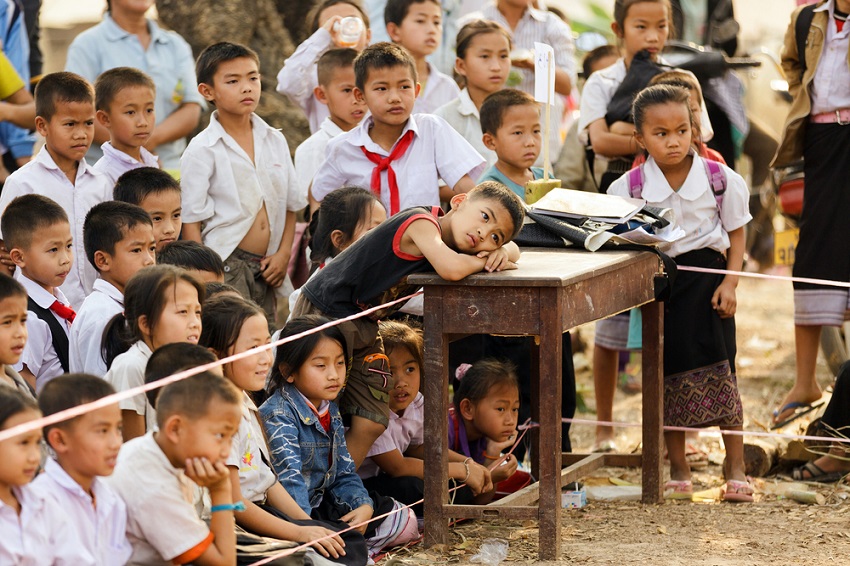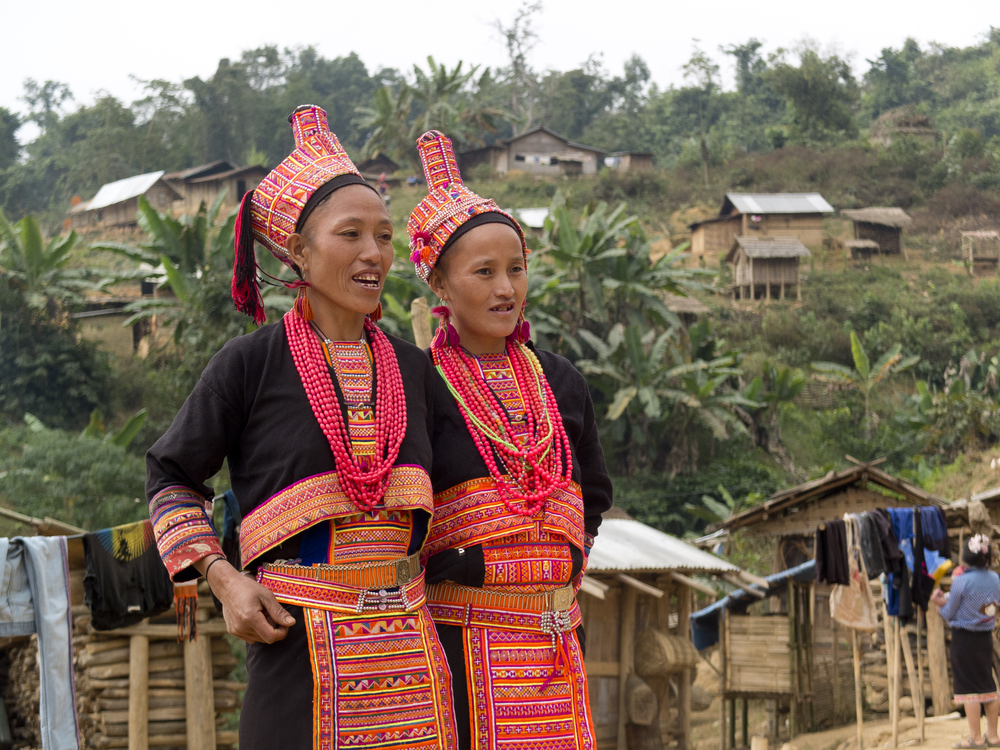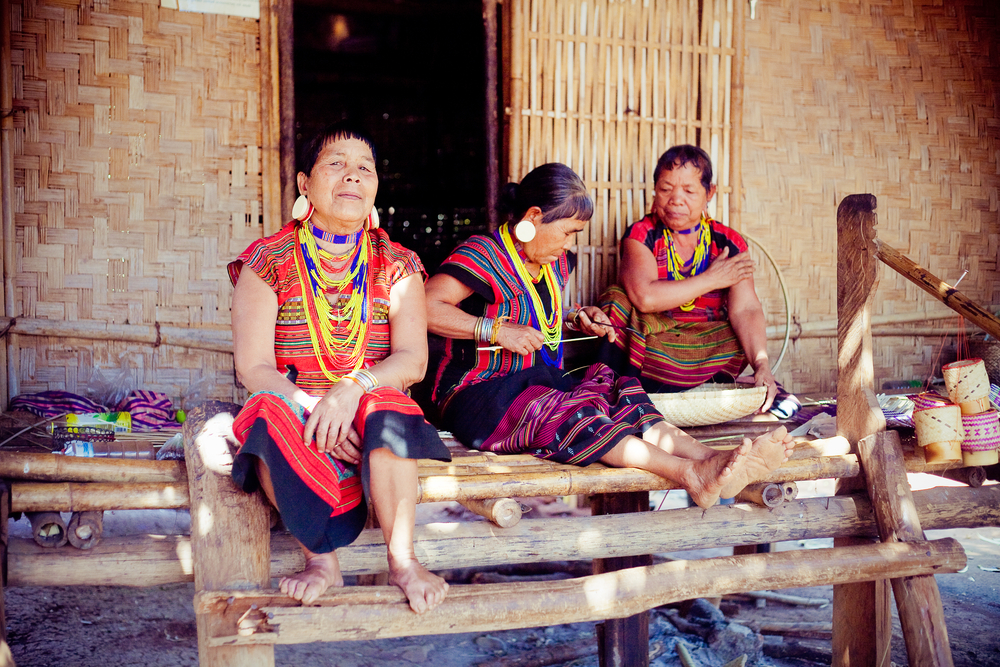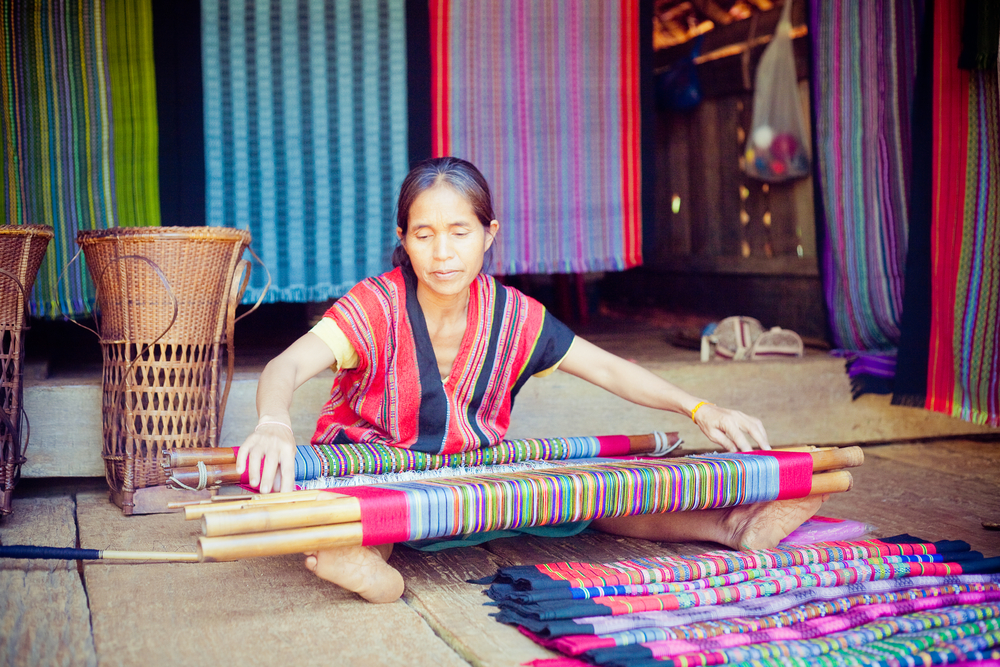Laos - fact sheet
Location and area: located in Southeast Asia between latitude 14-23 north and longitude 100-108 east. Its time zone is 7 hours ahead of Greenwich as Thailand’s. It has an estimated area of 226,800 square kilometers with water area of 6,000 square kilometers. Laos is a landlocked country.
Territory: it is bordered by these 5 neighboring countries.
Laos shares a border of 423 kilometers with China to the North.
Laos shares a border of 1,810 kilometers with Thailand and 535 kilometers with Cambodia to the South.
Laos shares a border of 2,130 kilometers with Vietnam to the East.
Laos shares a border of 235 kilometers with Myanmar to the West.
Topography: Laos has mountainous landscapes to the North and East reaching to the West. 75 per cent of the area is covered with forests and mountains while the other 25 per cent is flat hills and river basins. Mekong River is the heart of this country running through 1,835 kilometers supplying agriculture, fishery, electricity production and transportations from north to south. It is also a natural border to the neighboring countries.
Climate: It is tropical due to Northeast Monsoon influences from November to April resulting in drought. Southwest Monsoon from May to October brings rainfall with average 100 rainfall days per year. Laos has three seasons ranging from summer between March to May with average temperature at 29-30 degree Celsius. It can be expected to be hot and drought and the highest temperature could reach 40 degree Celsius in April. Rainy season starts from May to November with highest rainfall at 3,000 millimeters per year at Annamese Mountain Ranges. Winter starts from November to March when the northern part is coldest especially at mountain peaks. The temperature is lowest in January to freezing point and average temperature is 10-15 degree Celsius.
Capital city: Vientiane
National Motto: Peace, independence, democracy, unity and prosperity
Population: approximately 6.7 million (July 2013). Laos has 49 tribes and 4 language families with population density at 24 persons/ square kilometers. Children aged 0-14 years old making 35.5%, adolescence to middle aged 15-64 years old making 60.8% and senior aged 65 years old and above making 3.7%. Average life expectancy is 63.14 years old with 3%birth rate.
Religion: Theravada Buddhism and animism
Languages: Lao is the official language while tribal languages are spoken along with the official language. French is sometimes spoken in government offices and trading. English is spoken with international communities and in educational sphere.
Education: Literacy rate is 73%. The education budget takes up 15% of GDP. Compulsory education takes 5 years starting with 5 years of primary schools, 4 years of secondary school and 3 years of high school. Institutional education takes 4 years while intermediate vocational schools take 2 years and advanced vocational schools takes 3 years. However, Laos is still lack of vocational institutions and higher education staff. It is putting efforts in improving and establishing institutions in order to create 10,000 vocational staff within the academic year of 2013-2014.
Currency: Kip
National Day: 2nd December since it was the day when Laos had revolutionized its regime. (สำนักข่าวกรองแห่งชาติ, 2557, น.365-366)
Topography and natural resources
Laos is famous for forests and mountains. With abundant natural resources and mountainous landscapes especially in northern part, it is located on the precious land called “Suvarnabhumi” or Indochinese Peninsula sharing borders with Thailand, Vietnam, Myanmar, Cambodia and China. Thus, Laos is a landlocked country. Instead, it has Mekong River running through. In addition to forest resources, Laos also has mineral resources sparsely found across the country such as gold, copper, aluminum, salt and calcium oxide. Mining is booming around these areas. (วิทย์ บัณฑิตกุล, 2555, น.47)
Topography:
In general, the topography consists of plateau and plain. Plateaus are mountainous and valleys with its peak at approximated 9,000 feet, being full of forests. 80 per cent of the area is dried out and is not suitable for agriculture, while the other 20 per cent is Mekong River basin is rich and agriculturally suitable. (ศูนย์อินโดจีนศึกษา วิทยาลัยการบริหารรัฐกิจ มหาวิทยาลัยบูรพา, 2551, น.17)
Lao topography can be understood with these 3 parts:
The northern mountainous area is complicated mountain ranges consisting of three parts. The mountainous areas nearby Ju River and other waterways in Trannin plateau being 3,600-4,500 feet above sea level are the origin of rivers. The valleys at Mekong River basin are complicated mountain ranges with the most abundant forest resources of the country where Mhong or Lao Terng lives.
The southern plateau has its territories reaching from Southeast plateau to Phuan and to Cambodian border. There are three major highlands in this area, Phuan Plateau (Chiang Kwang District), Nakai Plateau (Kham Muan District) and the southern plateau, where Lao Terng and Khmu live, they believe in animism, work in highland agriculture or rice terrace and shifting cultivation.
The central plain is plains nearby Mekong River and other the rivers with the riches soil of all. It is the breadbasket of the country in which it lies Vientiane Plain, Savannakhet Plain and Champasak Plain reaching to Cambodian border. Lao Loum live there and work in rice farming and cultivation along Mekong River.
Woods and Minerals:
Most of the areas in Laos are covered with mountains and woods making up the estimated 110,000 square kilometers or 47per cent of the country. The richness of the Lao woods supplies economic woods like teak, Iron wood and other hardwoods. The wooden areas are mostly found in Sam Nuae, Hua Phun District and the northern part of Laos. Herbs are also abundant there creating jobs for the people collecting and exporting the herbs to neighboring countries. (วิทย์ บัณฑิตกุล, 2555, น.58) In addition, Laos is full of minerals such as gold, coal, tin, copper, jewelry, aluminum, manganese, lime and steel. These are the resources generating much income to Laos, and mining industry has played a vital role in Lao economy. (วิทย์ บัณฑิตกุล, 2555, น.61)
Mekong River:
Mekong River or Mae Nam Khong in Lao is the major and the most important river of Laos as it is the natural border between Thailand and Laos on the west from Loei Province to Ubonratchathani Province. Big and populous cities are located along the river with Mekong running 1,835 kilometers through Laos. Its general characteristics consist of numerous islets and rocks with strong currents and steep banks. The river is getting wider when running to the south. (ศูนย์อินโดจีนศึกษา วิทยาลัยการบริหารรัฐกิจ มหาวิทยาลัยบูรพา, 2551, น.19) Mekong appears running strong when reaching Luang Phrabang-Vientiane and Savannakhet and Khon Phapheng that is 13 kilometers in width and is a border between Laos and Cambodia. Mekong River’s geography affects the characteristics of population and political units so vividly including its unique history. (มาร์ติน สจ๊วต-ฟอกซ์, 2553, น.9) The southernmost Mekong which is the border between Laos and Cambodia has distinctive characteristics that spreads in a fan-like shape creating countless islets. When it is drought, the water surface covers 480 square kilometers surrounding those islets. So, this area is known as” the four thousand islets in the river.” (ศุภชัย สิงห์ยะบุศย์, สุรศักดิ์ พิมพ์เสน และ เสริม ผลเพิ่ม, 2545, น.116-117) Mekong running through Champasak is blocked by hard rocks creating a beautiful waterfall and islets, while the surrounding area is river basin being perfect for rice farming. Champasak, thus, has been a major source of rice farming for so long. The people there earn a living by rice farming, fishery and animal husbandry or it is simply called a culture of rice-fish culture. (ศุภชัย สิงห์ยะบุศย์, สุรศักดิ์ พิมพ์เสน และ เสริม ผลเพิ่ม, 2545, น.97-98) In addition, a plenty of freshwater fishes in Mekong River has been a nurturing source of fishes and a freshwater fishery for export. On the other hand, Khon Phapheng Waterfall, the biggest waterfall in Southeast Asia, has become another tourist attraction that is so important to southern Laos and Laos as a country. (ศุภชัย สิงห์ยะบุศย์, สุรศักดิ์ พิมพ์เสน และ เสริม ผลเพิ่ม, 2545, น.267-269)
Mekong River is so important in many aspects regarding agriculture, folk fishery, domestic and international electricity productions, major transportation from the north to south including trade routes between Laos and its neighboring countries. The river is the origin of legends, beliefs and traditions.
Political and economic situations:
Lao administration
Laos saw a change in regime from absolute monarchy to the Lao’s People Democratic Republic on 2nd December 1975 led by The Lao People’s Revolutionary Party or LPRP, whose hegemony has been present until now. Prince Suphanouvong is the first President of Laos or Head of State with his presidency term of 5 years. The current Preseident is Chummali Xayasone who is also Secretary General and one of the committees of Lao’s People Revolution Party. (วิทย์ บัณฑิตกุล, 2555, น.31)
Laos has 16 administrative divisions and one municipality that is Vientiane, the capital city. The 16 administrative divisions are Phongsali, Luang Namtha, Udomxay, Bokeo, Luang Phrabang, Xam Neua, Xayaburi, Xieng Khouang. Vientiane, Bolikhamsai, Khammouane, Savannakhet, Salavan, Sekong, Champasak and Attapeu. The capital city of Vientiane formerly Walls of Vientiane is a special administrative region that was separate from Vientiane District in 1989. (วิทย์ บัณฑิตกุล, 2555, น.34)
The Lao’s People Revolution Party is exposed to Marxist-Leninist Political Philosophy that is a fundamental idea revolutionizing productions and a culture with its operating organizations in forces, ministries, divisions, schools, hospitals and other small offices across the country. It is to guide and support every sectors to work and operate effectively (ทรงคุณ จันทจร, 2551, น.6-7), therefore, Lao administration is governed by a one party system with ultimate ruling power and by one parliament, the National Assembly of the Lao PDR acting as legislative office and judiciary in charge of national budgeting, legislating laws including Act of Parliament and monitoring the administration.
Head of State has power to take directions in making administrative policies and takes control of administration. Prime Minister is the leader of the government being in charge of making policies running the Party. The administrative organization consists of legislation, administration and judiciary. (วิทย์ บัณฑิตกุล, 2555, น.37)
In addition, mass organizations contributing to social accountabilities have been established by the Lao’s People Revolution Party and are supported by the government consisting of 1. Lao People’s Revolutionary Youth Union: LPRY acting under the party’s guideline in order to defend the nation, improve economy and support Socialism 2. Lao Labor Union providing training to help improve quality of labor life and defend the nation 3. Lao Women Union providing training and education as well as protecting women rights to defend and build the nation. 4. The Lao Front for National Construction, the most notable organization, including people of every segment regarding class, gender, tribe and religion with its ultimate mission to build a foundation of governance, to maintain peace, to improve a culture and a unification among the tribes. It also supports freedom of choosing a religion and a belief, gender equality and improves quality of life of the people under socialist guidance by the party. (ทรงคุณ จันทจร, 2551, น.8-9)
Economy Lao economic developments have two significant phases.
- The socialist economic system (1975-1985) was effective for a long time after the regime change in 1975. Its international trades were reserved for the socialist and communist countries causing economic depression that led to poverty, shortage of consumer goods, inflation, poor administration and production. The government, thus, reviewed their economic policies and drafted the first economic and social development plan. (ทรงคุณ จันทจร, 2551, น.3)
Lao first plan showed the efforts in developing economy under socialist-Soviet guidance that placed important on self-reliance agriculture and trades among the communist countries. As a result, the economic growth was lower than they had expected.
- The free market system (1986-present) The current government reformed the country and its economy under a policy of “a new imagination” after it had seized power in 1975. It started adopting the free market system in the 1990s resulting in better economic developments of Laos over the past 20 years. (วิทย์ บัณฑิตกุล, 2555, น.40)
The policy of a new imagination is included in the economic and social development plan 2 that turns to opening the country and employs market mechanism supporting trades and international investments. The economic and social development plan 3 (1991-1995) and plan 4 (1996-2000) are clearer as they are to achieve the purposes. Thus, the government ruled out the to-be-developed areas into 3 regions and 6 districts.
North Laos: Xieng Khouang is designed to be the main area where it supports livestock productions, while Luang Phrabang is a location of the old capital city and archeological sites being suitable for tourism. Bokeo and Luangnamtha bordered by Thailand, Myanmar and Yunnan of China are a special economic zone serving Economic Quadrangle project.
Central Laos: Vientiane and Khum Muan are major districts serving as a trade and industrial area with a new economic town being set up nearby Thai-Lao Friendship Bridge. The fully-industrialized town is established at Xithani. On the other hand, Khum Muan District has Hinpoon River, Tern River and Saebangfi River running through and the location is perfect for building dams. It is richest with different minerals like silver, gold, tin, plaster, potash, and can be a transportation to Vietnam. Therefore, it is developed to be a mineral industrial area.
South Laos: Salawan, Sekong, Savannakhet and Champasak are major districts for trade, agricultural and tourist developments. Savannakhet is facing opposite Mukdahan of Thailand which is a border crossing Thai-Lao Mekong River Bridge. It is being developed to be a free trade zone with highways reaching to Hue and Danang Port of Vietnam.
Salawan, Sekong, Champasak and Attapeu are the areas suitable for agriculture and animal husbandry, while Champasak is the old Champasak Kingdom housing amny ancient sites and natural tourist attractions. (สุรชัย ศิริไกร, 2548, น.213-214)
In conclusion, free trades and investment encouragements have increased with a clear goal creating Laos to be a center of electricity productions for export. Agricultural improvements, trades and tourism with a cooperation among the neighboring countries in Economic Quadrangle project and Greater Mekong Subregional of 6 countries are being seen. Laos joined and became a member country of ASEAN in 1997 with a policy to develop Laos to be the center of trades and transportations in this region because it is the only country that is bordered by the 6 neighboring countries like China, Vietnam, Myanmar, Thailand and Cambodia. Lao future economic developments heavily relies on the economic developments of ASEAN countries and China. (สุรชัย ศิริไกร, 2548, น.267) It aims at deliberating the country from poverty in 2020.
Lao major incomes come from electric energy as it has water resources to produce and supply both domestic and international electricity according to a policy of “Battery of Asia”. Its GDP has risen to 27% from selling electricity to Thailand. (ศูนย์อินโดจีนศึกษา วิทยาลัยการบริหารรัฐกิจ มหาวิทยาลัยบูรพา, 2551,น. 32)In terms of agriculture, Laos has a cultivation area of 40% with important plants such as coffe, rubber tree, rice and corn. Important plantations occur nearby Mekong River. In addition to this, new plans for agricultural development such as co-planting rubber trees with Malaysia are seen. Coffee is the important exported goods which is mostly planted in the south as it is the best quality especially in Champasak. (กนกพรรณ อยู่ชา, 2539, น.62) Since Laos has abundant natural resources, it offers wood concessions such as teak, mahogany and eagle wood. The same goes to mineral mining like gold, copper, potash, bauxite. coal, zinc and jewelry. (สำนักข่าวกรองแห่งชาติ, 2557, น.367) Most of the small industries take place in Vientiane such as cotton textile and beer brewery. According to the government’s plans to encourage tourism, Laos is to be the center of Indochina tourism. The five major cities are developed serving different purposes. (1). Vientiane is famous for its historical sites and shopping malls. (2). Luang Phrabang is the northern center of tourism with interesting natures and history. (3) Champasak has natural tourist attractions such as Khon Phaphen Waterfall and Koh Donkong including the ancient castle like Wat Phu Castle. It shows Lao ways of life. (4) Savannakhet is the tourist and trade center of Thailand, Laos and Vietnam. (5) Huay Xai and Bokeo are the connecting points of tourism of sub-regional areas in Quadrangle Economic that is northern Thailand, Myanmar and southern China. (กนกพรรณ อยู่ชา, 2539, น.102-103)
Lao economic development’s situation and trend
Laos has aimed at being one of the rice exporters in 2015, while in 2013 it contributed 596 million US dollars from tourism. Trade and Tourism organization of EU chose Laos to be the best country in tourism and culture in 2013. However, the government issued a restriction plan that temporarily stopped exporting coal in 2015 in order to supply its domestic consumption. (สำนักข่าวกรองแห่งชาติ, 2557, น.368)
Society and Culture:
Laos including other countries in Southeast Asia especially mainland like Laos, Thailand, Cambodia and Myanmar shares a similar culture regarding belief, religion, language, ethnic groups and way of life. In ancient times, the culture was not limited by territories of ethnic groups as it is at the present time. Now people identify themselves with certain groups. For example, Mrs. Prani Wongtes once talked about the tribal awareness of Southeast Asian people that the characteristic of ancient groups could be viewed as a tribe that had a shared culture, language and other aspects like political establishments, economy and society. However, those were not well-organized and integrated. The government organization had its center as a state and did not have clearly-written borders like the nation states. (ปราณี วงษ์เทศ,2543, น.288)
Srisak Wanliphodom said that Southeast Asian people’s awareness of and belief in tribes reflected their attitudes and worldviews. They did not live separately, but had contacted each other since a pre-historic time. It is difficult to believe any tribe or race could claim they had not blended in with different groups and had maintained their cultural uniqueness without influences of neighboring countries. With geographical surroundings of Southeast Asia being mainland, archeological evidences confirmed there had been contacts between the mainland people and the foreigners both on land and by sea at least 2,500 years. (อ้างใน ปรานี วงษ์เทศ, 2543, น.286)
National Costume
Lao national costume for female is usually dressed with Sarong or hand-woven cotton Sarong with decorative patterns and a beautifully woven breast cloth or earth tone cotton and silk cloth. The women also wear a delicate pattern silver belt and wear a hair bun decorated with flowers. Men wear earth tone silk or a delicately woven piece of cloth with a Raj Pattern shirt and a loincloth or a delicate pattern cloth being placed onto a shoulder. Lao national costume or Tai-Lao costume is very popular as it is worn on every occasion. (วิทย์ บัณฑิตกุล, 2555, น.126-127) Wearing Sarong has become a student uniform reflecting the Lao people are maintaining their unique costume culture. That is different from other countries in Southeast Asia, who have adopted western costumes on daily basis. Lao women prefer wearing jewelry made of gold or silver, especially the latter that is so famous among tourists having an interest in its unique carved patterns besides Lao hand-woven cloths.
In addition to Lao National Costume, the ethnic costumes are differently unique such as Phutai, Tai Dam and Tai Khao whose patterns of Sarong and woven cloths are very delicate.
Language and Literature:
The official and mainstream language that is widely spoken is Tai-Lao language whose lexicon pronunciation resembles the Thai-Isan language. In terms of linguistics, Lao and Thai-Isan languages are categorized into the same group of Thai-Tai family as Lao language has a similar writing system to Thai language regarding isolating word-forming, noun classifier and sentence order characteristics. (สำนักงานราชบัณฑิตยสภา, 2558, น.3)
Professor George Seyday gave his opinion on how Laos’ distinctive and long-endured letters have originated is that it might have developed from Thai letters invented by King Ramkhamhaeng the Great. The letters had originated in the ancient city of Sukhothai before spreading to Lanna and Lan Chang. However, the Thai letters in Lan Chang became Lao letters. Maha Vasilaveeravong has his opinion that Lao letters has existed for hundreds of years or even thousands of years before King Ramkhamhaeng’s invention (อ้างใน พิษณุ จันทร์วิทัน, 2556, น.15). Lao lexicon can be categorized into 2 groups, original Lao words and Bali-Sanskrit rooted words including borrowed words. Though Lao written language is different from the former due to a singular stipulation of writing system, it is not radically different when compared to other languages in its neighboring countries. The Lao letters have not been romanized in a way that changes its written form like Thai letters during Field Marshal P. Pibulsongkram’s period. There has been an attempt in preserving the language as much as possible, so it is not surprising Lao language is able to maintain its uniqueness and has spread in a way that is more sustainable than other languages like Lanna. Therefore, Lao language developments reflect how the society, culture and politics have changed over the years.
Lao folklores having existed since ancient times vary. Lao proverbs are similar to Thai-Isan proverbs. Lao wisdoms and Lao rhyme forming are also similar to Thai aphorism. Puzzling proverbs using metaphors has been another form of Lao proverbs, while its verse and poetry resembles Thai’s with little different in details. Lao literature having existed since the ancient times is mostly attributed to heroism. Some heroic folklores have both Thai and Lao versions with different details reflecting a shared belief, culture and folklore.
Bibliography
กนกพรรณ อยู่ชา. (2539). สาธารณรัฐประชาธิปไตยประชาชนลาว: ภูมิหลังทางการเมือง และสถานภาพทาง เศรษฐกิจ. กรุงเทพฯ สมาคมไทย-ลาว: สถาบันเอเชียศึกษา จุฬาฯ.
ทรงคุณ จันทจร. (2551). แขวงหลวงพระบาง สาธารณรัฐประชาธิปไตยประชาชนลาว: เศรษฐกิจ สังคม วัฒนธรรม. มหาสารคาม: สถาบันวิจัยศิลปะและวัฒนธรรมอีสาน มหาวิทยาลัยมหาสารคาม.
ปรานี วงษ์เทศ. (2543). สังคมและวัฒนธรรมในอุษาคเนย์. กรุงเทพฯ: ศิลปวัฒนธรรม.
พิษณุ จันทร์วิทัน. (2556). เสน่ห์ภาษาลาว (พิมพ์ครั้งที่ 4). กรุงเทพฯ: สถาพรบุ๊คส์.
สจ็วต-ฟอกซ์, มาร์ติน. (2553). ประวัติศาสตร์ลาว (จิราภรณ์ วิญญรัตน์, ผู้แปล/ กาญจนี ละอองศรี และ ปรียา แววหงษ์, บรรณาธิการ). กรุงเทพฯ : มูลนิธิโตโยต้าประเทศไทย
สำนักข่าวกรองแห่งชาติ. (ธันวาคม 2557). ข้อมูลพื้นฐานของต่างประเทศ 2558. สืบค้นเมื่อวันที่ 15 กันยายน 2558, จาก https://www.nia.co.th/niaweb58/data_gb.asp.
สำนักงานราชบัณฑิตยสภา. (2558). เพลินภาษาเพื่อนอาเซียน ฉบับราชบัณฑิตยสภา (พิมพ์ครั้งที่ 2). กรุงเทพฯ: สำนักงานราชบัณฑิตยสภา.
สุรชัย ศิริไกร. (2548). การพัฒนาเศรษฐกิจและการเมืองลาว (พิมพ์ครั้งที่ 4, ฉบับปรับปรุง). กรุงเทพฯ : โครงการจัดพิมพ์คบไฟ.
วิทย์ บัณฑิตกุล. (2555). สาธารณรัฐประชาธิปไตยประชาชนลาว. กรุงเทพฯ: สถาพรบุ๊คส์.
ศุภชัย สิงห์ยะบุศย์, สุรศักดิ์ พิมพ์เสน และ เสริม ผลเพิ่ม. (2545). โครงการสารคดีลาวตอนล่าง: สะหวันนะเขต สาละวัน เซกอง จำปาสักและอัตตะปือ : ห้าแขวงลาวตอนล่าง. กรุงเทพฯ: โครงการอาณาบริเวณศึกษา 5 ภูมิภาค.
ศูนย์อินโดจีนศึกษา วิทยาลัยการบริหารรัฐกิจ มหาวิทยาลัยบูรพา. (2551). ข้อมูลพื้นฐานสาธารณรัฐประชาธิปไตยประชาชนลาว. ชลบุรี: ศูนย์อินโดจีนศึกษา วิทยาลัยการบริหารรัฐกิจ มหาวิทยาลัยบูรพา.





